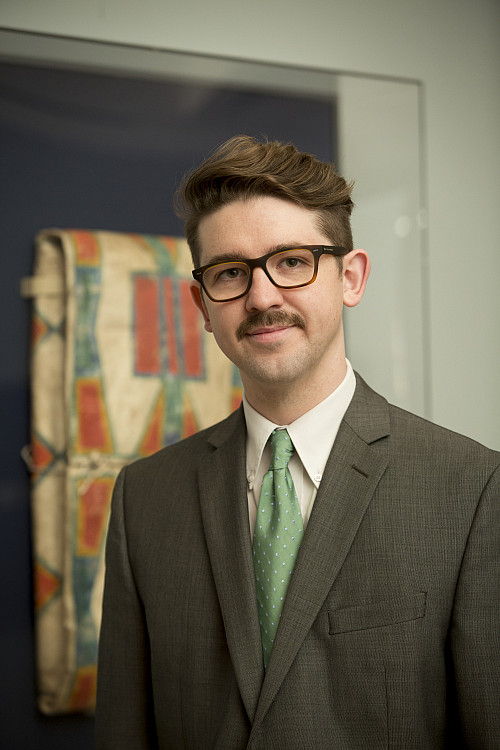Sharing Stories of Indigenous Art
As a curator of Native American Art at the Saint Louis Art Museum, Alex Marr’08 draws on the intellectual training and internships made possible at Beloit College.

“Throughout my studies at Beloit College, I pursued opportunities to work with its museum collections. That included holding a work study position in the Wright Museum of Art in my senior year.”
Classroom experiences were also fundamental to his career development. Faculty modeled intellectual curiosity and passion, and focused topics courses were pivotal.
“The courses I took in phenomenology, the historiography of French sociology, and the anthropology of religion were as valuable for theories and histories as they were for demonstrating how professors saw the world, undertook their own work, and identified material that continuously renewed their sense of wonder.”
Mentorship and grounding in the liberal arts also proved critical to his development as an intellectual and museum studies professional.
Professor of art history Jo Ortel’s mentorship and the art history major were transformational. By Alex’s third year at Beloit, he knew that he wanted to continue his studies. The question was whether to pursue a master’s degree or a PhD. Jo helped him understand that doctoral, interdisciplinary studies made sense: He had a firm grounding in art history and had gained practical museum experience.
Opportunities to engage with the world beyond Beloit also informed Alex’s decision to pursue a career in the museum world rather than academia.
“For two summers, I interned at the Roger Brown Study Collection in Chicago. A member of the Chicago Imagists artist group, Brown not only was an inveterate collector, but lived with his collection in his home. Brown helped inspire the interest in folk and outsider art that led me to write an honors thesis under Joy Beckman’s supervision on the paintings of the self-taught Wisconsin artist Nick Englebert.”
It was a seminar in contemporary Native American art taught by Jo Ortel, however, that convinced Alex that Native American art studies was a growing field requiring more research, exhibition, publication, and specialized knowledge.
“All of the questions I had been asking across the curriculum came to bear in that seminar. Among the speakers Jo invited to class was the eminent artist and curator Truman Lowe. She also took us to lectures off campus. I was shown art that could sustain a lifetime of asking, learning, and doing.”
The interest in Native American art sparked at Beloit led to graduate studies. As a PhD student in Visual and Cultural Studies at the University of Rochester, Alex held fellowships sponsored by the National Museum of Natural History, the Center for the Advanced Study in Visual Arts at the National Gallery of Art, and the Portland Art Museum in Oregon. Additionally, he contributed to a publication about the Thaw Collection at the Fenimore Art Museum in New York.
“Through academic and museum training, I have come to specialize in collections of historic Indigenous art. My job allows me to practice the skills and knowledge that I began to develop at Beloit.”
Reflecting on his education at Beloit, Alex notes that focused time with specialists in a range of disciplines was critical for his pursuit of interdisciplinary doctoral studies and his choice of a career in a field where knowledge is constantly being generated and methods are deeply collaborative.
“The ability to focus deeply on specific topics in seminars and then identify connections across the curriculum helped me to pinpoint questions that motivated my research through graduate school and continue to fuel my work today. What is the difference between language and visual signification? How does identity function in the visual world? How have people across space and time responded to shared experiences and materials in different ways? Relationships with faculty were the fundamental experiences that shaped my career.”


